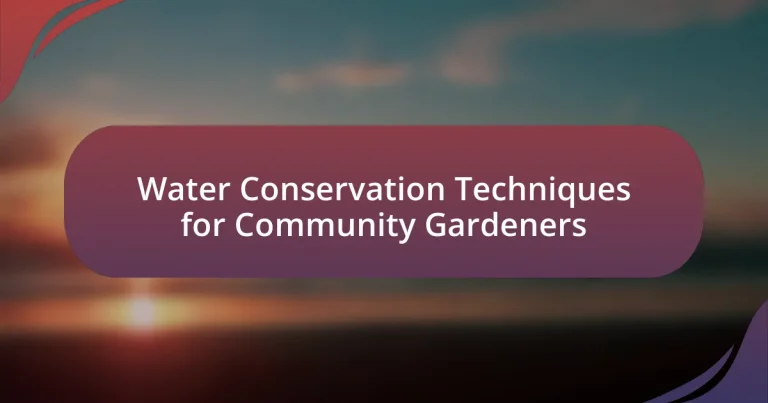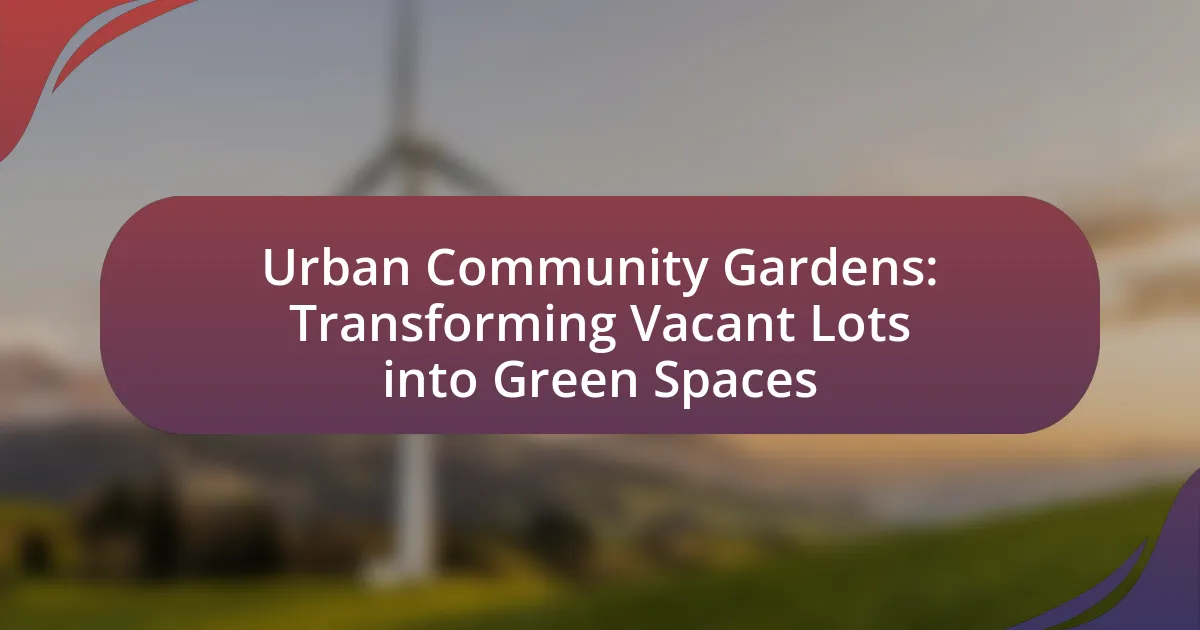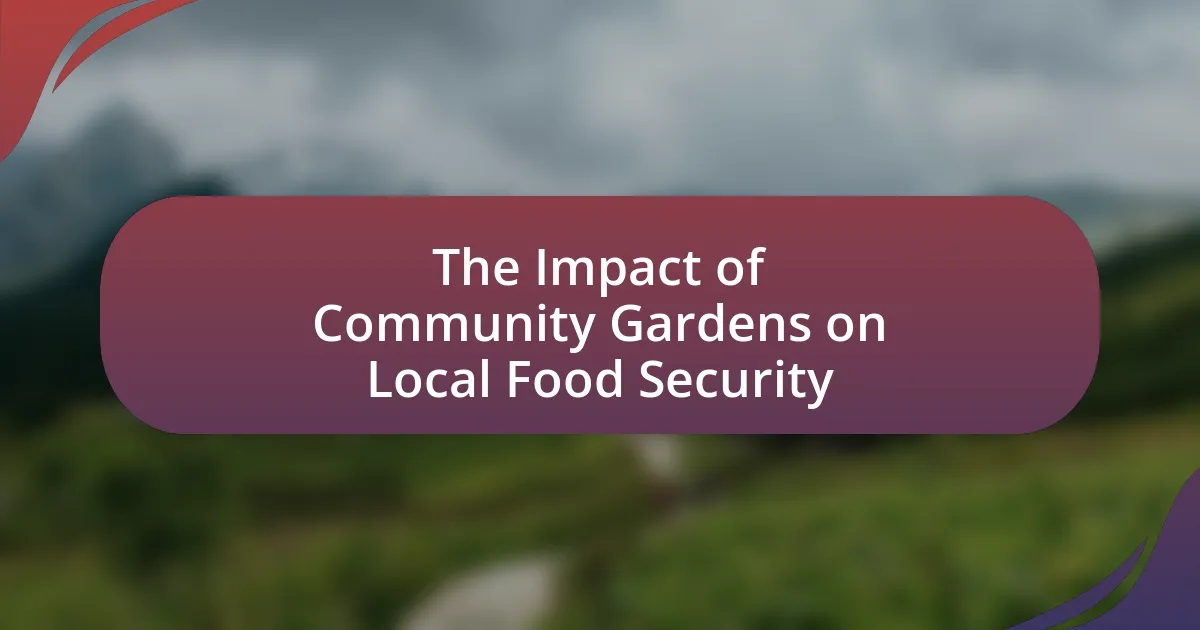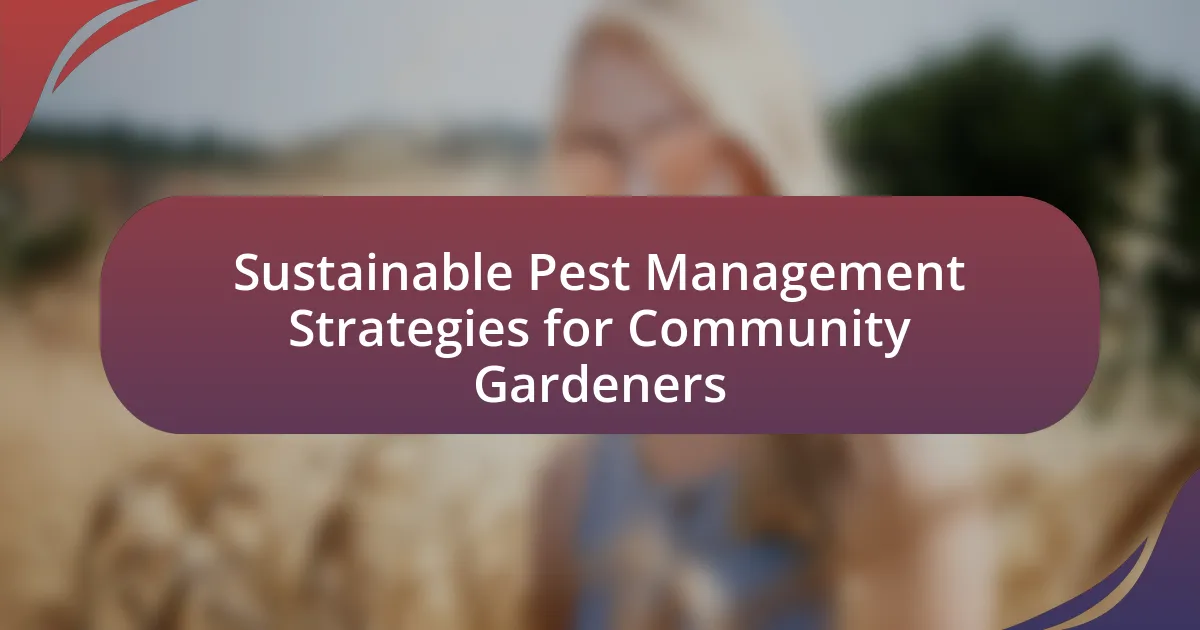Water conservation techniques for community gardeners are essential for promoting sustainable gardening practices and optimizing water usage. Key methods include drip irrigation, which minimizes evaporation and runoff; mulching, which retains soil moisture; rainwater harvesting, which reduces reliance on municipal water supplies; and selecting drought-resistant plants that thrive in low-water conditions. These techniques not only enhance plant health and growth but also contribute to healthier soil and ecosystems within community gardens. By implementing these strategies, gardeners can significantly decrease water consumption, improve resource management, and foster resilience against drought conditions.
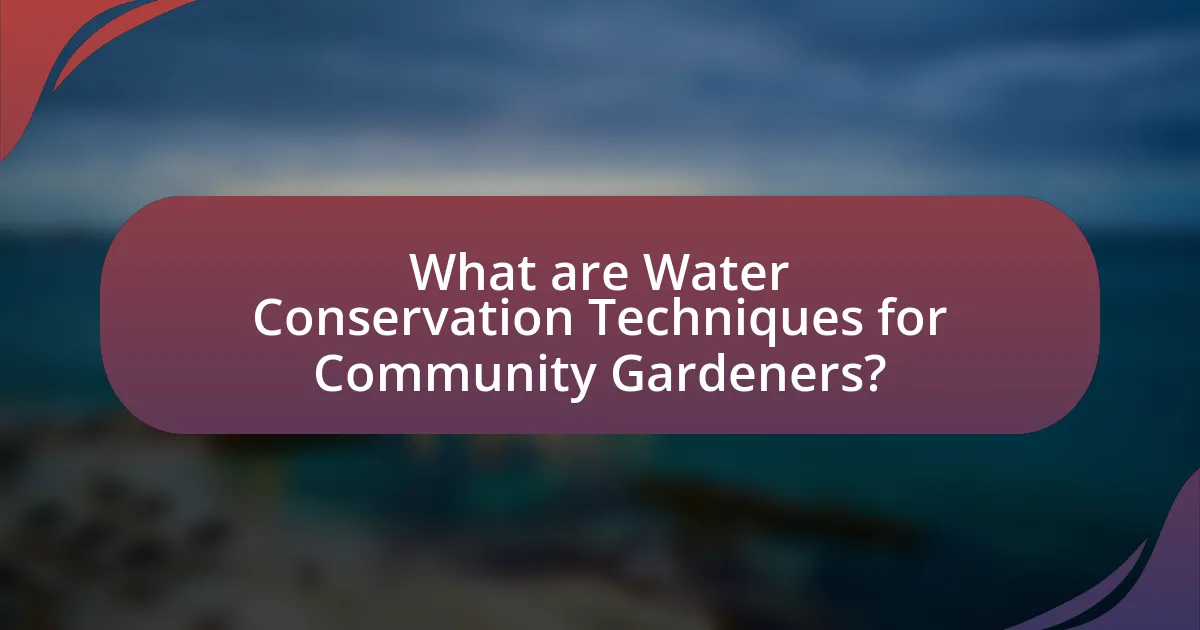
What are Water Conservation Techniques for Community Gardeners?
Water conservation techniques for community gardeners include drip irrigation, mulching, rainwater harvesting, and selecting drought-resistant plants. Drip irrigation delivers water directly to the plant roots, minimizing evaporation and runoff, which can save up to 50% more water compared to traditional methods. Mulching helps retain soil moisture and reduces the need for frequent watering by covering the soil with organic materials, such as straw or wood chips. Rainwater harvesting involves collecting and storing rainwater from rooftops, which can be used for irrigation, thus reducing reliance on municipal water supplies. Additionally, choosing drought-resistant plants can significantly lower water usage, as these plants are adapted to thrive in low-water conditions. These techniques collectively contribute to sustainable gardening practices and efficient water use in community gardens.
How do these techniques benefit community gardens?
Water conservation techniques benefit community gardens by optimizing water usage, which enhances plant growth and sustainability. Techniques such as drip irrigation and rainwater harvesting reduce water waste and ensure that plants receive adequate moisture. Research indicates that implementing these methods can decrease water consumption by up to 50%, allowing gardens to thrive even in drought conditions. Additionally, these techniques promote healthier soil and reduce the need for chemical fertilizers, leading to more robust ecosystems within community gardens.
What impact do water conservation techniques have on plant health?
Water conservation techniques positively impact plant health by ensuring that plants receive adequate moisture while minimizing water stress. Techniques such as mulching, drip irrigation, and rainwater harvesting help maintain soil moisture levels, which is crucial for nutrient uptake and overall plant vitality. Research indicates that plants subjected to efficient water management practices exhibit improved growth rates and resilience against drought conditions, as evidenced by studies showing that mulched plants can retain up to 70% more moisture compared to unmulched plants. This enhanced moisture retention directly correlates with healthier root systems and increased plant productivity.
How do these techniques contribute to sustainability in gardening?
Water conservation techniques contribute to sustainability in gardening by reducing water usage and promoting efficient resource management. These techniques, such as drip irrigation and rainwater harvesting, minimize water waste and ensure that plants receive adequate moisture without over-irrigation. For instance, drip irrigation can reduce water usage by up to 60% compared to traditional methods, as it delivers water directly to the plant roots. Additionally, rainwater harvesting allows gardeners to collect and utilize natural precipitation, decreasing reliance on municipal water supplies and lowering the environmental impact associated with water extraction and distribution. These practices not only conserve water but also enhance soil health and biodiversity, further supporting sustainable gardening efforts.
What are the key principles of water conservation in gardening?
The key principles of water conservation in gardening include efficient irrigation methods, soil management, and plant selection. Efficient irrigation methods, such as drip irrigation and soaker hoses, minimize water waste by delivering water directly to the plant roots, reducing evaporation and runoff. Soil management practices, like mulching and maintaining organic matter, enhance soil structure and moisture retention, which decreases the need for frequent watering. Additionally, selecting drought-resistant plants or native species that require less water contributes to overall water conservation in gardening. These principles are supported by studies indicating that efficient irrigation can reduce water usage by up to 50%, while proper soil management can significantly improve water retention capabilities.
How does soil health influence water retention?
Soil health significantly influences water retention by enhancing the soil’s structure, organic matter content, and microbial activity. Healthy soil, characterized by a balanced composition of minerals, organic matter, and microorganisms, improves its ability to absorb and retain water. For instance, soils rich in organic matter can hold up to 20 times their weight in water, which is crucial for plant growth and sustainability. Additionally, well-structured soil promotes better aeration and drainage, reducing runoff and increasing infiltration rates. Research indicates that healthy soils can increase water retention by 30% or more compared to degraded soils, demonstrating the critical role of soil health in effective water conservation practices for community gardeners.
What role does plant selection play in water conservation?
Plant selection plays a crucial role in water conservation by determining the water needs of a garden. Choosing drought-resistant or native plants significantly reduces water consumption, as these species are adapted to local climates and require less irrigation. For instance, studies show that native plants can use up to 50% less water than non-native species, making them more sustainable choices for gardeners aiming to conserve water. By selecting appropriate plants, gardeners can create resilient landscapes that thrive with minimal water input, thereby promoting efficient water use and supporting overall environmental health.
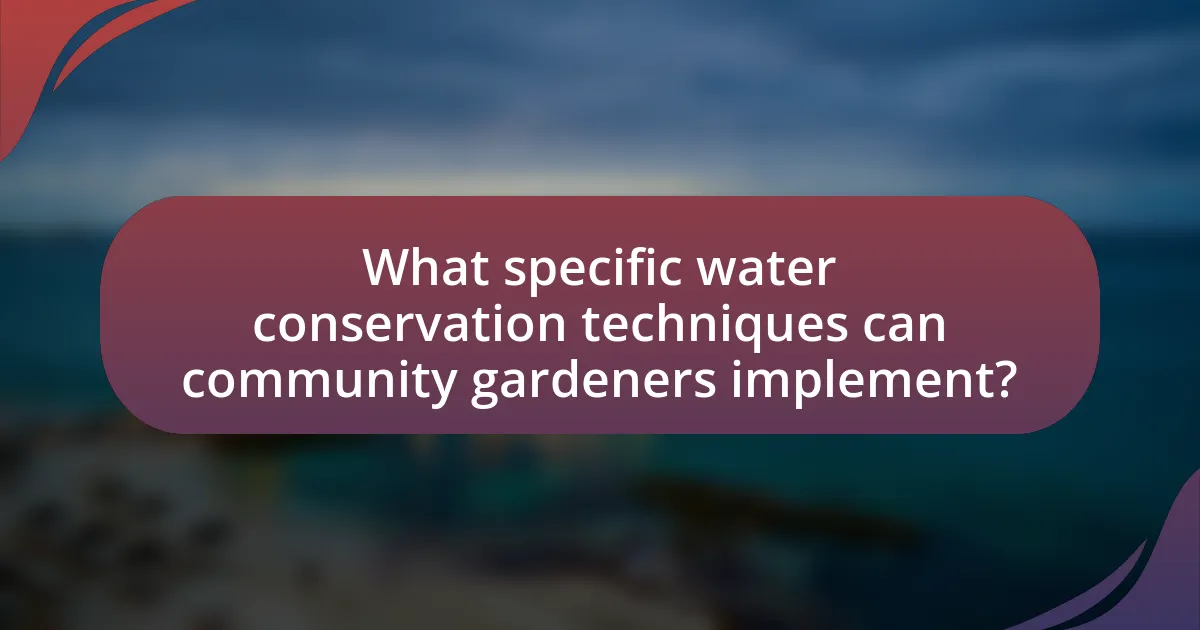
What specific water conservation techniques can community gardeners implement?
Community gardeners can implement techniques such as drip irrigation, mulching, rainwater harvesting, and using drought-resistant plants to conserve water. Drip irrigation delivers water directly to the plant roots, minimizing evaporation and runoff, which can reduce water usage by up to 50% compared to traditional watering methods. Mulching helps retain soil moisture and reduces the need for frequent watering by preventing evaporation. Rainwater harvesting systems can collect and store rainwater for irrigation, providing a sustainable water source. Additionally, selecting drought-resistant plants can significantly lower water requirements, as these plants are adapted to thrive in low-water conditions.
How can rainwater harvesting be utilized in community gardens?
Rainwater harvesting can be utilized in community gardens by collecting and storing rainwater for irrigation purposes. This method reduces reliance on municipal water supplies and promotes sustainable gardening practices. For instance, community gardens can install rain barrels or cisterns to capture runoff from roofs, which can then be used to water plants during dry periods. According to a study by the University of California, rainwater harvesting can reduce water costs by up to 50% for gardens, demonstrating its effectiveness in conserving water resources.
What are the steps to set up a rainwater harvesting system?
To set up a rainwater harvesting system, follow these steps: First, select an appropriate catchment area, typically a roof, to collect rainwater. Next, install gutters and downspouts to direct the rainwater into a storage tank. Ensure the storage tank is made of food-grade material and has a secure lid to prevent contamination. After that, incorporate a filtration system to remove debris and contaminants before the water enters the tank. Finally, connect a distribution system, such as hoses or drip irrigation, to utilize the harvested rainwater effectively in your community garden. These steps are essential for creating an efficient rainwater harvesting system that supports water conservation efforts.
What are the benefits of using rainwater for irrigation?
Using rainwater for irrigation offers several benefits, including cost savings, environmental sustainability, and improved plant health. Rainwater harvesting reduces reliance on municipal water supplies, leading to lower water bills for gardeners. Additionally, rainwater is naturally soft and free of chemicals found in treated water, which can enhance soil quality and promote healthier plant growth. Studies indicate that using rainwater can reduce the need for fertilizers, as it contains fewer salts and minerals, thus supporting better nutrient uptake by plants. Furthermore, rainwater collection helps mitigate stormwater runoff, reducing erosion and pollution in local waterways.
What is the importance of mulching in water conservation?
Mulching is crucial for water conservation as it reduces evaporation from the soil surface, thereby maintaining soil moisture. By covering the soil with organic or inorganic materials, mulching creates a barrier that minimizes water loss, which is particularly important in community gardens where water resources may be limited. Studies have shown that mulched areas can retain up to 50% more moisture compared to bare soil, significantly enhancing water efficiency in gardening practices.
How does mulching reduce evaporation?
Mulching reduces evaporation by creating a barrier that limits the amount of water lost from the soil surface. This barrier, typically made from organic materials like wood chips or straw, helps to retain soil moisture by reducing direct exposure to sunlight and wind, which are primary factors in evaporation. Studies have shown that mulched areas can retain up to 50% more moisture compared to bare soil, significantly enhancing water conservation in gardening practices.
What types of materials are best for mulching?
Organic materials such as wood chips, straw, grass clippings, and shredded leaves are best for mulching. These materials improve soil structure, retain moisture, and suppress weeds. For instance, wood chips can decompose over time, enriching the soil with nutrients, while straw provides excellent moisture retention and weed control. Research indicates that organic mulches can reduce soil temperature fluctuations and enhance water conservation, making them ideal for community gardeners focused on sustainable practices.
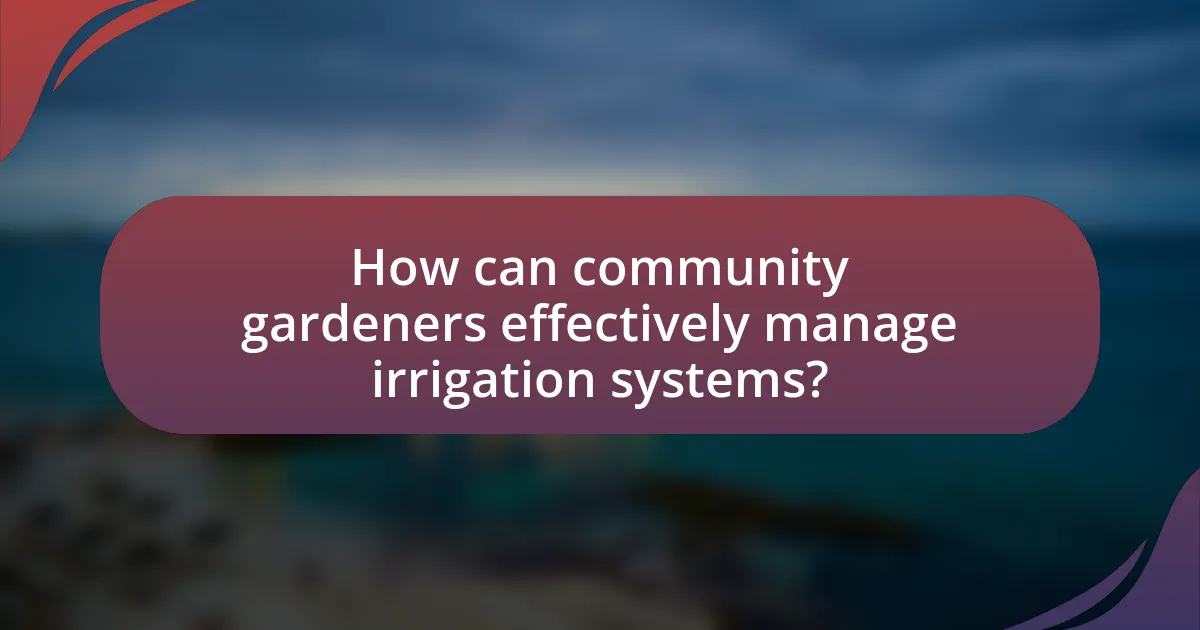
How can community gardeners effectively manage irrigation systems?
Community gardeners can effectively manage irrigation systems by implementing drip irrigation and scheduling watering times based on weather conditions. Drip irrigation delivers water directly to the plant roots, minimizing evaporation and runoff, which can save up to 50% more water compared to traditional methods. Additionally, using rain gauges and soil moisture sensors helps gardeners determine the optimal times for irrigation, ensuring that plants receive adequate moisture without overwatering. Studies show that these techniques not only conserve water but also promote healthier plant growth by providing consistent moisture levels.
What are the advantages of drip irrigation over traditional methods?
Drip irrigation offers several advantages over traditional irrigation methods, primarily in water efficiency and crop yield. This method delivers water directly to the plant roots, minimizing evaporation and runoff, which can lead to water savings of up to 50% compared to conventional methods. Additionally, drip irrigation promotes healthier plants by providing consistent moisture levels, reducing the risk of disease associated with overwatering. Studies have shown that crops irrigated with drip systems can yield 20-90% more than those using traditional methods, as the targeted watering encourages better growth and productivity.
How does drip irrigation improve water efficiency?
Drip irrigation improves water efficiency by delivering water directly to the root zone of plants, minimizing evaporation and runoff. This targeted approach allows for precise control over water application, ensuring that plants receive the optimal amount of moisture needed for growth. Research indicates that drip irrigation can reduce water usage by 30-50% compared to traditional irrigation methods, such as sprinklers, which often waste water through evaporation and overspray. Additionally, studies show that crops irrigated with drip systems can yield higher outputs due to improved water availability, further demonstrating the effectiveness of this method in conserving water resources.
What are the maintenance requirements for drip irrigation systems?
Drip irrigation systems require regular maintenance to ensure optimal performance and longevity. Key maintenance tasks include checking for clogs in emitters and filters, inspecting the system for leaks or damage, and flushing the lines periodically to remove sediment buildup. Additionally, it is essential to monitor the pressure and flow rates to ensure they remain within the recommended range for efficient operation. Regular maintenance can prevent costly repairs and ensure that water is delivered efficiently to plants, thereby conserving water resources effectively.
How can community gardeners monitor and optimize water usage?
Community gardeners can monitor and optimize water usage by implementing soil moisture sensors and adopting drip irrigation systems. Soil moisture sensors provide real-time data on soil hydration levels, allowing gardeners to water only when necessary, thus preventing overwatering. Drip irrigation systems deliver water directly to the plant roots, minimizing evaporation and runoff, which can lead to significant water savings. Research indicates that using drip irrigation can reduce water usage by up to 50% compared to traditional watering methods. Additionally, rainwater harvesting systems can be installed to collect and store rainwater for irrigation, further enhancing water conservation efforts.
What tools are available for measuring soil moisture levels?
Various tools are available for measuring soil moisture levels, including soil moisture sensors, tensiometers, and moisture meters. Soil moisture sensors provide real-time data by measuring the volumetric water content in the soil, while tensiometers gauge the tension or suction of water in the soil, indicating moisture availability to plants. Moisture meters, often handheld, offer a quick assessment of soil moisture levels through electrical conductivity or resistance. These tools are essential for effective water conservation in community gardening, ensuring optimal irrigation practices and plant health.
How can gardeners adjust their watering schedules based on weather conditions?
Gardeners can adjust their watering schedules based on weather conditions by monitoring rainfall and temperature to determine the appropriate amount of water needed for their plants. For instance, during hot and dry weather, plants typically require more frequent watering, while cooler and rainy conditions may necessitate less frequent watering. Research indicates that plants lose more moisture through evaporation in high temperatures, which can increase their water needs by up to 50%. Additionally, using tools like rain gauges and soil moisture sensors can help gardeners make informed decisions about when to water, ensuring efficient water use and promoting plant health.
What are some best practices for water conservation in community gardens?
Best practices for water conservation in community gardens include implementing drip irrigation systems, using mulch to retain soil moisture, and selecting drought-resistant plant varieties. Drip irrigation delivers water directly to the plant roots, minimizing evaporation and runoff, which can save up to 50% more water compared to traditional watering methods. Mulching with organic materials like straw or wood chips helps reduce evaporation from the soil surface, maintaining moisture levels and reducing the need for frequent watering. Additionally, choosing drought-resistant plants can significantly lower water usage, as these species are adapted to thrive in low-water conditions, further promoting sustainable gardening practices.
How can community gardeners educate others about water conservation techniques?
Community gardeners can educate others about water conservation techniques by organizing workshops and hands-on demonstrations that showcase effective practices such as drip irrigation and rainwater harvesting. These educational events can provide participants with practical knowledge and skills, allowing them to implement water-saving methods in their own gardens. Research indicates that community-based education initiatives significantly enhance awareness and adoption of sustainable practices, as evidenced by a study published in the Journal of Environmental Management, which found that participants in community gardening programs reported a 30% increase in water conservation efforts after attending workshops.
What common challenges do gardeners face in implementing these techniques?
Gardeners commonly face challenges such as limited access to water resources, inadequate knowledge of efficient watering methods, and the high initial costs of implementing water conservation techniques. Limited access to water can hinder the ability to adopt practices like drip irrigation or rainwater harvesting, especially in areas with water scarcity. Additionally, many gardeners may lack the necessary training or information on how to effectively implement these techniques, leading to inefficient use of water. The initial investment required for systems like rain barrels or irrigation technology can also deter gardeners from adopting these practices, despite their long-term benefits in water conservation.
